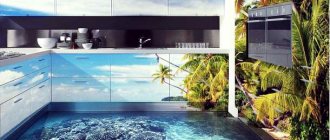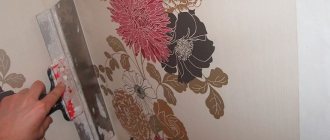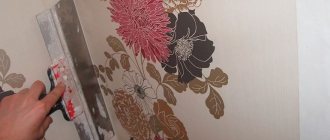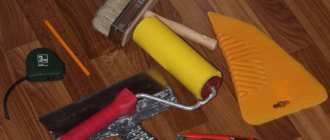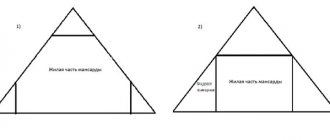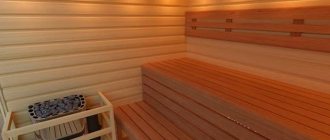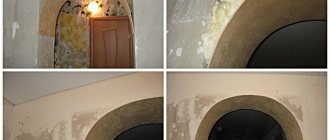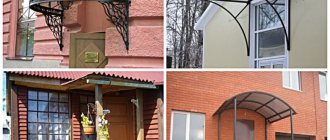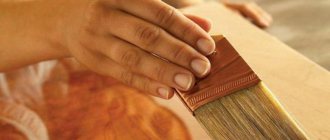Fur coat plaster is one of the simplest and most cost-effective finishing methods. The process of applying the solution does not require careful surface preparation, special equipment or special skills, so all work can be done with your own hands. Decorative coating hides minor wall imperfections: cracks, recesses, small protrusions. Suitable for both building facades and interior decoration.
Composition selection
You can make fur coat plaster yourself or purchase a ready-made composition.
The first option is more economical - the solution is prepared from available materials: water, sand and cement. You can also use gypsum instead of cement. However, the mineral mixture is not without its drawbacks: cement plaster “shuba” is inelastic, so cracks appear on it, and gypsum coating is not suitable for exterior finishing because it absorbs water.
Another option is ready-made formulations. They can be dry, requiring dilution with water before use, or completely ready for use. Builders prefer dry mixtures: they are cheaper, weigh less, and are more convenient to deliver to the repair site.
Silicone plaster is supplied completely ready for use. It’s easier to work with, even a non-professional can handle it. Polymer compositions are durable, elastic, do not crack after drying, and are suitable for almost any surface (from brick to plasterboard). Their cost is higher, but the coating created by polymer fur coat plaster is moisture resistant and has a long service life.
Descriptions of popular brands, photos
Many manufacturers offer “fur coat” plaster for covering external facades and walls. To make the right choice, you need to get to know the brands and the features of their products in detail. Popular brands include Ceresit, Knauf, Mineral Decor, Perfekta and others.
Knauf
Knauf is a proven and positively proven manufacturer of building materials. It offers such a variety as Knauf Diamant “fur coat”, which is sold in the form of a dry mixture of 25 kg. Knauf has the following advantages:
- suitable for all types of wall decoration;
- after drying, a rough and granular structure with a pronounced appearance appears;
- can be repainted multiple times;
- applied with any tool;
- water-repellent characteristics;
- not afraid of atmospheric phenomena.
1 m2 requires 3.8 kg of dry mixture.
Lakra
Structural plaster from a domestic manufacturer - Lakra with a fur coat effect. Its advantages:
- increased whiteness;
- hides all the imperfections of the walls;
- easy to apply with a roller;
- moisture-resistant, not afraid of atmospheric phenomena;
- the finished coating is highly durable, but allows the walls to “breathe”;
- good adhesion to any coating - concrete, brick, plasterboard;
- absence of solvents and odor;
- the painted surface can be washed.
The consumption of this solution is about 2 kg per 1m2.
Elbrus
Ready-made diluted decorative plaster with a fine “fur coat” effect is sold in 15 kg buckets and is immediately ready for use. It can be applied to any type of surface, creating a snow-white coating and optical volume. Main advantages:
- affordable product;
- can be worn with a regular roller;
- low consumption of solution - a 15 kg bucket is enough to finish 25 m2;
- increased strength, resistance to temperature and humidity changes;
- used as a finishing material;
- not afraid of frequent wetting, can be washed.
Ceresit
The Ceresit mixture is ideal for use in Russian weather conditions; its advantages include good performance properties and an affordable price for a wide range of customers. The consumption of the fine-grained type is 18 kg/m2, the medium-grained type is 2 kg/m2, the coarse-grained type is 2.5-3.5 kg/m2.
Perel
Perel lime-cement based plaster contains polymer additives that give it water-repellent properties and a super-white color. Consumption is 4-4.5 kg/m2 with a layer thickness of 0.2 cm.
Bergauf
The Bergauf company offers high quality plaster at an affordable price with good performance and technical properties. There are mixtures in dry form, as well as ready-made ones.
S.P.S.
White SPS plaster is used for decorating and structuring relief surfaces, insulating building facades from the outside and finishing walls from the inside; it has hydrophobic properties, resistance to ultraviolet radiation and changing weather conditions. You can work them using professional equipment.
Advantages and disadvantages
Fur coat plaster is not a new method of interior or exterior decoration, but it remains popular because it has several significant advantages:
- low price for materials and tools;
- the ability to independently carry out all the work;
- increasing heat and sound insulation (provided the finished coating layer is sufficiently thick);
- possibility of repeated staining;
- aesthetic appearance of finished surfaces.
Among the disadvantages:
- Rapid contamination: dust and dirt accumulate on the embossed surface, and it is difficult to clean it.
- Fragility (in the case of using cheap cement mixtures).
Properties of decorative plaster
Decorative textured plaster is used to create a finishing coating. It is excellent for exterior decoration of building facades and for finishing interior surfaces. It is often used for finishing borders and arches. This coating, in addition to its attractive appearance, has other positive characteristics. The advantages of a fur coat include:
- peat insulating properties;
- soundproofing qualities;
- protection of walls from destructive atmospheric phenomena;
- ease of use, finishing can be done by hand;
- possibility of easy restoration of damaged areas;
- aesthetic characteristics;
- affordable price.
Preparing the base
Plastering under a fur coat with your own hands begins with preparing the surfaces. The wall should be cleaned of any objects attached to it, dirt and dust should be removed. It is advisable to remove the old finishing material, especially if it does not hold firmly.
To ensure that the composition adheres tightly to the wall, notches are made on it with a sharp object, such as a chisel.
Then they move on to priming. The solution is applied using a wide brush or roller. For very uneven substrates, it is better to use a sprayer so that the liquid penetrates into all cracks and grooves.
When the primer is completely dry, proceed to applying the “fur coat” plaster.
Preparation of the solution
To make your own composition you will need a filler and a binder. Cement, gypsum, lime or clay are used as the latter. The most accessible filler is sand. It is preferable to take unadulterated mid-fraction and pre-sieve it.
Do-it-yourself “fur coat” plaster is prepared as follows:
- one part of cement and three parts of sand are combined;
- the resulting mixture is poured into a mixing container;
- For every kg of dry matter take 200 ml of water;
- mix thoroughly with an electric drill with a special attachment or a construction mixer;
- stand for 5 minutes, mix again.
The result should be a mass reminiscent of sour cream in consistency. There is no need to make the solution too thick: the consumption increases and it is inconvenient to apply.
How to apply a “fur coat” with a broom
Why still “fur coat”? This plastering method has several advantages:
- You don't need complex and expensive materials or mechanisms.
- Even a person without professional construction skills can handle the job.
- “Shuba” does not create a large load on the walls, so it can be used for both new and old buildings.
- High strength and durability of the finish.
- Large selection of shades (in fact, any pigment will do).
Surface preparation before application
- Remove old coating. Be sure to remove old plaster or tiles.
- To achieve maximum adhesion to the base, the wall surface must be rough. If you are plastering a smooth brick wall, apply grooves and notches over the entire surface, then secure a special construction mesh.
- If the size of the unevenness on the wall is more than 2-3 cm, you definitely need a layer of plaster. If the unevenness is small, rough plaster may not be applied.
- To prevent mold from appearing on the surface, treat it with an antiseptic. This applies primarily to old buildings.
- When the antiseptic has completely dried, apply a layer of deep penetration primer.
Preparation of the solution
The plastering solution must be prepared from cement and sand. For M-300 cement, use a ratio of 1:2.5 (sand: cement). If you use M-400 or M-500 cement, the proportions will be 1:3 and 1:4, respectively.
If you want a colored mortar, use white cement rather than grey. The composition of the plaster should include purified river sand, which was previously sifted through a sieve.
When the sand and cement are thoroughly mixed, pour water into a bucket, and then stir the resulting mass until it becomes homogeneous (no lumps).
What degree of thickness should the solution have? It depends on what texture of the “fur coat” you need. The thicker the solution, the coarser the grain size. The optimal density is the consistency of liquid sour cream.
To prevent the solution from settling during work, pushing water to the top, add washing powder to the composition. For 10 liters of solution, 30-40 ml of powder is enough.
Materials and tools
To work you will need:
- mixing container;
- electric drill or construction mixer;
- sandpaper (fine-grained);
- brushes and planks;
- tinting paste;
- construction rule;
- textured roller and spatula;
- stick and broom.
For quick and high-quality application, you can use a special machine for fur coat plaster. This is a device consisting of a container within which flexible metal plates rotate. When the handle is rotated, the organ sprays the solution onto the wall.
Application methods
There are several ways to apply fur coat plaster. The appropriate one is chosen taking into account the processing area, the desired texture and your experience.
Broom
This method requires a minimum of materials.
Using a birch stick and a broom is only advisable for treating small surfaces, since manually spraying the solution takes a lot of time. Procedure:
- A broom is dipped into a container with a solution and the composition is poured onto it.
- Take a stick in one hand, placing it parallel to the surface being treated.
- Hit the broom against the stick so that the splashes fly onto the wall.
- Repeat all operations until the wall is covered with an even layer of the composition.
Machine for applying fur coats “organ organ”
The process of applying “shuba” plaster using a stick and a broom takes a lot of time, and it will be difficult to achieve an even layer the first time, so it is rarely used.
Brush
Using a brush and a plank is another outdated method of applying fur coat plaster. It is suitable for both exterior and interior decoration.
The brush is dipped into a container with a solution, brought to the wall, turned over with the bristles up and passed along it with a board, from the wall towards you. The resulting splashes will fall on the wall, covering it.
Roller
Roller application is the optimal solution for inexperienced finishers. No additional equipment is needed here; all you need is a roller, a rule and a spatula. Achieving an even first coat will not be difficult, and the work goes quickly.
The solution is taken onto a spatula and distributed over the surface. Using the rule, level the layer. Walk along the wall with applied plaster with a roller. Do this quickly until the solution dries.
If the work is carried out indoors and you need to get a fine texture, after drying the plaster is treated with sandpaper.
Compressor
Using a manual sprayer to apply “fur coat” plaster or a compressor will get the job done the fastest.
The finished coating will be of high quality, the layer of solution will be uniform. Compressors will help not only speed up the process, but also achieve the desired texture: to create a fine texture, pour a liquid solution into the device, and to obtain a coarse texture, prepare a thick mixture.
Net
You can apply plaster under a fur coat using a fine mesh - this method is also not difficult. The mesh is pressed to the prepared surface, and the solution is applied to it with a trowel. When finished, the mesh is carefully peeled off, and the plaster remains on the wall, maintaining its relief texture.
Grated Fur Coat
This type of decorative coating looks completely different from the usual version: the texture is smoother, the protruding tops are leveled, the roughness remains only in the recesses. What a grated fur coat looks like can be seen in the photo.
The application technique can be divided into two stages:
- First, the plaster is applied to the walls to be finished using one of the methods described above. The fastest way would be to use a gun and a compressor.
- After the solution begins to set, the texture is rubbed down. For smoothing, use a metal trowel or trowel. Lightly pressing the tool to the surface, move it from top to bottom. The result is smooth protruding islands and rough inclusions in the depressions of the relief.
Watch the video for more details:
Staining and tinting
Decorative plaster “fur coat” is supplied in white and gray shades.
If you want to paint the surface in light shades, use white; gray is better suited for obtaining rich or dark tones.
You can change the color of the composition during mixing or after application and drying. The first method is more labor-intensive, since the solution is prepared in small batches, and it is necessary to achieve an exact match of the second and subsequent portions of the first. In the process of diluting the mixture with water, you need to measure the exact volume of the solution and the color added, and then strictly adhere to these proportions when making subsequent batches.
The color of the plaster can be changed by painting. Use regular paint, apply it with a brush or spray.
Making and applying “shuba” plaster is not particularly difficult. If you follow the work technology, you can get a smooth, durable and aesthetic coating without significant costs.

